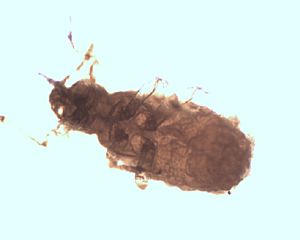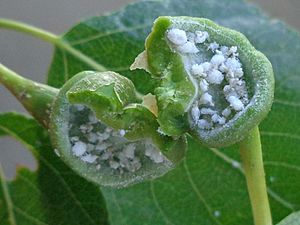Poplar spiral gall aphid facts for kids
Quick facts for kids Pemphigus spyrothecae |
|
|---|---|
 |
|
| Pemphigus spyrothecae under microscope | |
| Scientific classification | |
| Kingdom: | |
| Phylum: | |
| Class: | |
| Order: | |
| Family: |
Aphididae
|
| Subfamily: |
Eriosomatinae
|
| Genus: |
Pemphigus
|
| Species: |
P. spyrothecae
|
| Binomial name | |
| Pemphigus spyrothecae Passerini, 1860
|
|
The Pemphigus spyrothecae, also known as the poplar spiral gall aphid, is a social insect. These tiny creatures show amazing "altruistic" (selfless) behaviors. They create special homes called galls on poplar trees. Some aphids act as brave defenders of their colony. They sometimes even give up their own lives to protect their home.
These gall locations are very important. Plants only have a short time to create a gall. So, it's vital for the aphids to have a strong defense system. This helps them keep their valuable galls safe. Defense is especially needed when the gall opens up. This allows winged aphids to leave or helps the colony get rid of waste. Repairing these openings can take up to 10 days. During this time, the gall is open to dangerous predators.
Contents
What Does the Poplar Spiral Gall Aphid Look Like?
P. spyrothecae aphids can be green, red, or yellow. They feel smooth to the touch. Their unique homes, the galls, form on the leaf stalks (called petioles) of the Populus nigra tree, also known as the black poplar.
As the petiole thickens and twists, the gall forms a spiral shape. It looks a lot like the inside of a snail's shell. The first female aphid to start the gall, called a fundatrix, is pale green. She is born from an egg that survived the winter. These fundatrices allow the next generation of winged aphids to grow inside the gall.
Galls usually become fully grown in late August or early September. They change color from green to red as they mature. At this stage, the winged aphids (called alatae) leave the gall. They exit through many small holes along the spirals. You can find P. spyrothecae in many places. They live across Europe, North Africa (like Tunisia), western Siberia, Pakistan, and some parts of Canada.
How Are Poplar Spiral Gall Aphids Classified?
Pemphigus spyrothecae belongs to a large group of insects called Aphididae, or aphids. These are soft-bodied insects that often live in big groups on plants. They are part of the order Hemiptera. This group includes insects with special mouthparts for sucking.
Aphids can have wings or be wingless. They have antennae with six segments. All aphids have two claws on their feet. They also have a pair of short tubes called cornicles sticking out from their last body segment. There's also a small projection at the end of their abdomen called a cauda. Pemphigus spyrothecae is part of the genus Pemphigus.
Behavior and Life in the Gall
The Amazing Aphid "Soldiers"
How We Discovered Aphid Soldiers
The special aphid "soldier" first shows its unique traits as a young larva. This is the stage after it fully develops in the egg. Inside the galls, there are two types of young larvae. One type has thick legs and attacks insects that enter the gall. The other type has normal legs.
Scientists noticed that thick-legged larvae of a similar aphid species attacked moth larvae (a predator). This happened when the moth larvae were put into their galls. Because of this, a scientist named Aoki thought that the thick-legged P. spyrothecae larvae also defended their galls. He was right! He later saw that the normal-legged larvae were "reproductives-to-be" (they would reproduce). The thick-legged larvae were the defenders, or "soldiers." This was the first time aphid soldiers were found outside of East Asia.
These soldiers look different from other aphids of their species. First, the young soldiers are usually more aggressive. They also have thick back legs and a sharp part called a stylet. They use this stylet to attack invaders.
Defending the Gall Fortress
P. spyrothecae can defend their gall home very well. They do this by having soldiers in the colony. When a single predator entered galls with soldiers, the soldiers usually killed the predator. Only a few soldiers were lost in the fight. But in galls with only non-soldiers, the predators killed and ate the aphids.
In a later study, scientists Foster and Rhoden (1997) looked at how well soldiers defended the gall. They changed the number of soldiers and non-soldiers in galls on poplar trees. When galls had both soldiers and non-soldiers, they were ten times less likely to be attacked by a predator. This was compared to galls with only non-soldier aphids.
These results showed that soldiers are very good at defending against predators in nature. Earlier lab tests had already shown that soldiers could stop special gall predators. But this study proved that this protection also works in the wild. Five different predators attack P. spyrothecae galls. These include a specialist predator called A. minki, and generalist predators like S. ribesii.
How Soldiers Attack Predators
Like other aphid species that attack predators, P. spyrothecae soldiers use a single thrusting motion. They pierce the predator with their stylets. They rarely stab repeatedly. These aphids can also use their legs—sometimes all six—to squeeze the predator. This action aims to tear the predator's outer skin (called a cuticle) and damage its insides.
Scientists noted that attacking predators was costly for the soldiers. This means that soldiers likely weigh the pros and cons before deciding to attack.
Family Ties and the Soldier Caste
P. spyrothecae aphids reproduce by cloning. This means that genetic relatedness within a colony is quite simple. An aphid is either a clone of its neighbors or it isn't. Since every generation inside the gall is highly related due to cloning, any genetic difference (besides a mutation) comes from aphids moving between galls. It's easy for aphids to move between galls. This is because colonies stay in their galls on the main host tree for a long time, only moving after summer ends.
Mixing Clones and Soldier Behavior
The genetic relationships within aphid colonies help explain why the selfless soldier role evolved in P. spyrothecae. Scientists used special DNA markers to see how much "clonal mixing" happened in the colony. Clonal mixing means that individuals from different clones (genetically identical groups) are mixed together. This could reduce the benefit of cooperation if it's wasted on unrelated clones.
Scientists thought that galls were important for the evolution of soldiers. Since a gall is valuable and can be defended, they expected it to stop other foreign clones from entering. However, they found that even though soldiers can move and even reproduce outside their own gall, clonal mixing was generally low. Because there's so little clonal mixing, there are few barriers to the evolution of selfless soldiers in this species.
Johnson et al. (2002) were the first to use specific DNA markers. This helped them understand how much genetic diversity was inside P. spyrothecae galls. Their studies also confirmed that aphids do move between galls.
Is Clonal Mixing an Adaptive Event?
Since data showed that all aphids moving between galls were soldiers, scientists believe these aphids can grow and produce winged emigrants in galls as a smart strategy of cloning. It's not just a random event. This supports the idea that soldiers evolved from specialized migrants. However, more studies on colonies with high clonal mixing would help scientists better understand the link between mixing and how much soldiers invest in defense.
Repairing the Gall Fortress
Gall repair is a great example of social behavior within P. spyrothecae colonies. Scientists made an opening in a gall, just like a natural one. They then saw more deaths from predators. In this case, there wasn't more investment in soldiers. So, scientists concluded that aphids don't adapt to short-term changes by having fewer clones (which would mean more soldier reproduction).
However, they did notice that the holes were repaired. This happened through new growth from nearby parts of the gall that were unharmed or protected. Scientists found that the soldiers were most likely responsible for this repair. This shows how widespread the selfless behavior is within this complex soldier group.
Experiments on Gall Defense
W. A. Foster studied how well galls were defended and the methods used. He took galls and put them in a lab. This allowed him to control the predators and the number of aphids. Anthocoris minki was identified as the main predator.
It was shown that only the first-instar soldiers were responsible for defense. They successfully stopped predators from entering. If predators did get in, the soldiers killed them. The soldiers that cannot reproduce tend to live closer to the gall opening. The aphids that can reproduce live farthest from the opening. It was also found that some soldiers died while defending.
When a ladybird larva (Adalia bipunctata) was put into the gall, the soldiers would walk onto the predator. They would insert their stylets into the predator's outer skin. Sometimes, they would even pierce the skin with their back legs. This experiment was also done with only non-soldiers. In these cases, the predator was not killed. This clearly shows that only the soldiers play a role in gall defense.
While attacking a predator, a fluid called haemolymph would ooze out of the aphids. This caused the aphids to stick to the predator. Scientists found that with larger predators, more aphids were stuck after the predator was defeated. The predator's survival rate is linked to the number of soldiers present. With only 50 soldiers, 50% of predators died. With 100 soldiers, 90% of predators died.
Why Are Aphid Soldiers Selfless?
The main reason for this selfless behavior is explained by kinship, or how closely related the aphids are. The average level of mixing in P. spyrothecae was very low (0.68%). This means there is a high degree of relatedness between members of the gall. So, it becomes clear that this is a "selfish act" in a way. By protecting the gall and their relatives, the soldiers are helping to preserve their own genes.
This soldier trait has evolved four separate times in different aphid species. This shows how important and beneficial this trait is for their survival. Even though soldier aphids protect against predators, they don't seem to defend against other aphids of the same species, even if those aphids are not clones.
Images for kids




